159 Facts About Steinway And The Pianos They Build
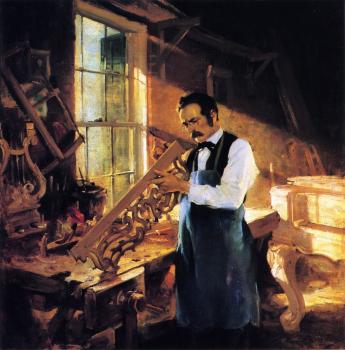 In 1836 Heinrich Englehard Steinway built his first piano in the kitchen of his home in Seesen, Germany which is commonly reffered to as the “Kitchen” piano. The piano is currently on display at the Metropolitan Museum of Art.
In 1836 Heinrich Englehard Steinway built his first piano in the kitchen of his home in Seesen, Germany which is commonly reffered to as the “Kitchen” piano. The piano is currently on display at the Metropolitan Museum of Art.
- Heinrich would build 482 pianos over the next decade.
- Heinrich Engelhard Steinway and his family would emigrate to the United States in 1850.
- On March 5, 1853, Steinway & Sons was founded, setting up shop on Varrick Street on the West Side of Manhattan, manufacturing square grand pianos.
- In 1853, the family decided to Americanize their name to “Steinway”
- In 1853, the family decided to Americanize their name to “Steinway” The company’s first piano, serial no. 483, was sold to a New York family named Griswold for $500. It is now displayed at New York’s Metropolitan Museum of Art.
- By 1854, just a year after founding the company, Steinway & Sons was making 2 pianos a week, and sold 74 pianos for the year.
- By 1856, Steinway & Sons sales rose to 208 pianos for the year, from 74 just 2 years before in 1854.
- In 1857, a piano was created with a lavishly carved case and legs. This piano, Serial #1225, is believed to be the first ever Steinway Art Case piano.
- On December 20, 1859, Patent #26532 was granted to Henry Steinway Jr. for the Overstung Plate, where by the longer bass strings were drawn over sections of other strings.
- By 1859, Steinway's least expensive piano sold for $275.
- In 1863, Henry Steinway became an American Citizen.
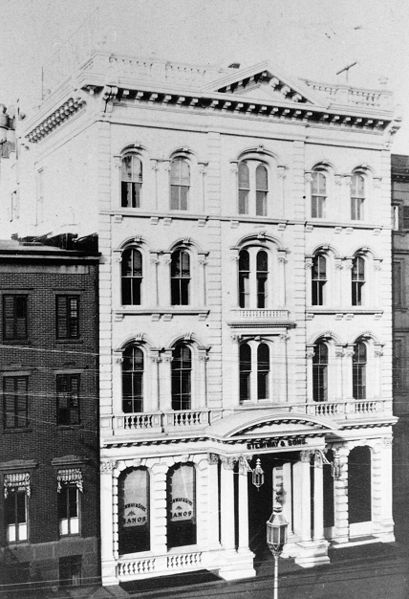 Steinway & Sons opened the first Steinway Hall on 14th Street in 1866, which had an auditorium of 2,000 seats.
Steinway & Sons opened the first Steinway Hall on 14th Street in 1866, which had an auditorium of 2,000 seats.
- 1867, William Steinway estimated that 90% of American Piano output was square pianos, 5% were uprights and 5% were grand pianos, he also characterized that grand sales were "scarce as angels' visits."
- In 1867, Steinway became the first American manufacturer to receive the “Grand Gold Medal of Honor” at the Paris piano exhibition.
- In 1871, William purchased the Steinway Mansion. The Mansion overlooking Bowery Bay on Long Island Sound was owned by Benjamin T. Pike Jr. who owned an optical supply business. He sold the estate to William for $127,500.
- The Steinway Mansion was recently put up for sale for $3.5 million in 2011.
- In 1871 Henry Englehard Steinway, founder of Steinway & Sons, died at 74 years of age.
- In 1871, Steinway sold 2,553 pianos, and was making pianos at a rate of 1 piano per hour, or 10 pianos per day.
- William Steinway engaged the great Russian pianist Anton Rubinstein to play Steinway pianos during an American concert tour in 1872, with 215 concerts in 239 days. It was a triumph for both Rubinstein and Steinway.
- In 1875 Steinway Hall opened in London.
- 1877 Oberlin College Conservatory, Oberlin, OH, becomes the first All-Steinway School.
- 1881, William Steinway, Son of Henry, became a millionaire, one of 400 in New York.
- 1881, Steinway manufactured more than 2,600 pianos.
- 1883 Alma Tadema Piano Model D #54538, The piano was sent to London in 1884 for inlay and paintings by noted Victorian Artist Sir Lawrence Alma-Tadema for Henry Marquand, Art Collector and 2nd President of the New York Metropolitian Museum of Art. Painting "Wandering Minstrels" above the keyboard. 9 Muses on the lid. Returned to NY City in 1887, then auctioned for $8,000 in 1903. Then moved to the Marin Beck Theater in Manhattan. In 1980 the Alma Tadema was sold at an auction for $360,000. Piano was then on loan to the Museum of Fine Arts in Boston.
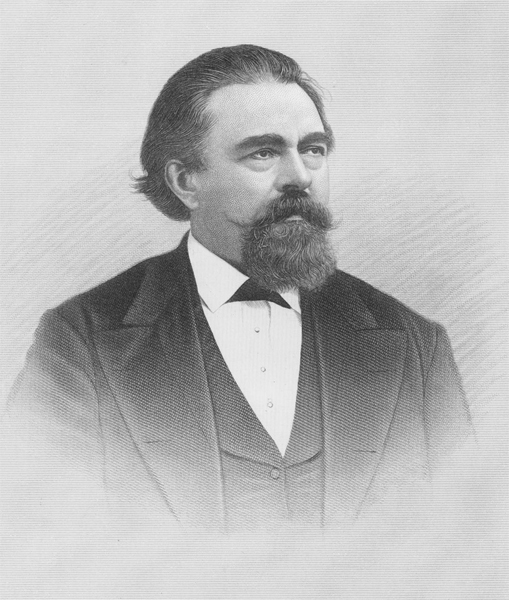 1884, Model D, #51,257 was completed in New York City on January 31, 1894. It is the very first modern Steinway Concert Grand Piano. Its salient features were developed by C.F. Theodore Steinway.
1884, Model D, #51,257 was completed in New York City on January 31, 1894. It is the very first modern Steinway Concert Grand Piano. Its salient features were developed by C.F. Theodore Steinway.
- 1888-Theodore Steinway enters into agreement with G. Daimler of Mercedes to manufacture parts for the American Mercedes Automobile and the engines as well as marine engines. This arrangement lasted at least until 1906.
- 1888-The last time a Square Grand was advertised.
- 1890-Steinway Hall on 14th Street Closed in anticipation of Carnegie Hall.
- 1891-Carnegie Hall opens. The Carnegie Music Hall seated 3,000 with standing room for another 1,000, the old Steinway Hall seated only 2,500.
- 1892-Paderewski signed on for a second tour for 60 concerts, which was a phenomenal success for Steinway & Sons as well.
- 1892-December 23, Christmas season, “Biggest retail trade ever done, sold 30 old and new pianos in one day.” as per William.
- 1897-Yale University School of Music, New Haven CT, becomes an All-Steinway School.
- In 1900 the retail price of a Steinway Model D was $1,400
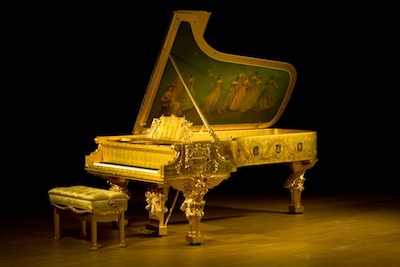 1902 -The 100,000th Steinway Piano was built and it was built by the “Art Piano case Department” for President Theodore Roosevelt to go in the East Room of the White House. It was gilded with gold leaf, and on the lid a painting entitled “America Receiving the Nine Muses” depicting 10 women in pink, mauve, and gray centennial revival style ball gowns against a vivid green background. American Eagles carved on the legs, valued at $7,500 (a D sold for $1600) and was given to the nation in 1903. The piano was donated to the Smithsonian when a new Steinway replaced it during the administration of Franklin D. Roosevelt. Today the historic Gold Steinway stands in the First Ladies Hall of the National Museum of American History.
1902 -The 100,000th Steinway Piano was built and it was built by the “Art Piano case Department” for President Theodore Roosevelt to go in the East Room of the White House. It was gilded with gold leaf, and on the lid a painting entitled “America Receiving the Nine Muses” depicting 10 women in pink, mauve, and gray centennial revival style ball gowns against a vivid green background. American Eagles carved on the legs, valued at $7,500 (a D sold for $1600) and was given to the nation in 1903. The piano was donated to the Smithsonian when a new Steinway replaced it during the administration of Franklin D. Roosevelt. Today the historic Gold Steinway stands in the First Ladies Hall of the National Museum of American History.
- 1902-The model “O” designed by Henry Ziegler was introduced. This was the introduction of lower prices for smaller pianos some grand pianos were cut in price by as much as a third. Prices of upright pianos were also cut with the introduction of the “Vertegrand”.
- 1904-model “K” was available for $500.
- 1911-Steinway & Sons sold more than 6,000 pianos
- 1912 – Model M, 5’6”, designed by Henry Ziegler was introduced, sold for $750 and 900 of these models were sold.
- 1922 – Model L introduced, an idea of Henry Ziegler, Vice President, and Frederick Steinway. The Model L replaced the Model O and sold for $1,575.
- 1923 - It was estimated that 56% of the 360,000 pianos produced in America were players.
- 1924-The Julliard School, New York, NY becomes an All-Steinway School.
- 1925-Steinway had 2,300 workers.
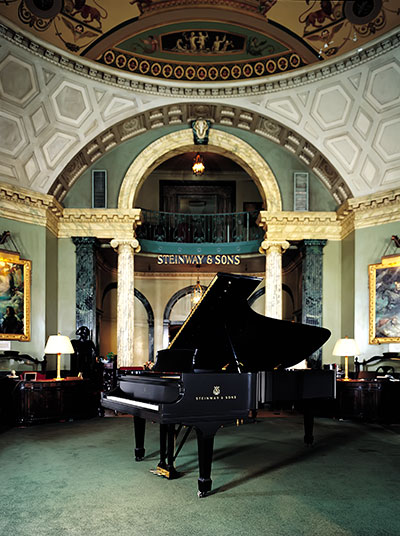 In 1925, Steinway Hall opened to its current location on West 57th Street.
In 1925, Steinway Hall opened to its current location on West 57th Street.
- 1928 - January 9, Horowitz arrived in America for a 30- concert tour. Performed with the New York Philharmonic at Carnegie Hall January 13-14-15. An ad to purchase a Steinway, “Instrument of the Immortals” with an endorsement by Horowitz.
- 1928 - January, Horowitz and Rachmaninoff met in the basement of Steinway Hall. There they played Rachmaninoff’s third Concerto. This piece became Horowitz’s trademark.
- 1929 - Curtis Institute of Music, Philadelphia, PA became an All-Steinway School.
- In 1930 the retail price for a Steinway Model D was $3,000.
- 1931 –1936 A small number of foremen, office workers, and hundreds of part-time piano makers ran the Steinway factory. The factory remained officially closed for 2 years during that period workers were brought back on an as needed basis.
- 1932 Steinway & Sons sold 900 new pianos. 888 Grand pianos and 12 uprights. They were not in the mass produced spinet business.
- 1936, Steinway model S was introduced, sold for $885.
- 1936: Diaphragmatic Soundboard Design - 1936 Patent #2051663
The quality of tonal resonance is directly linked to the quality of the Soundboard. The soundboard is considered the soul of the piano. The Steinway Diaphragmatic Soundboard permits a free and even response throughout the scale. It is thicker in the center and tapered as it approaches the inner rim of the grand piano. This construction not only permits the tone to travel more freely but also displaces a greater amount of air, factors that create a richer and more lasting tone.
- 1936: Accelerated Action - Patent #2031748 The touch of a Steinway is the most responsive and sensitive of any piano made. This is not opinion. It is a fact that results from the way the instrument is designed and manufactured. In fact, laboratory tests have proven that the keys on a Steinway piano can repeat 14% more quickly than the keys of any other piano. The same features that allow for the faster repeat also provides a much more sensitive, responsive keyboard, an aspect that can be appreciated even by beginning pianists.
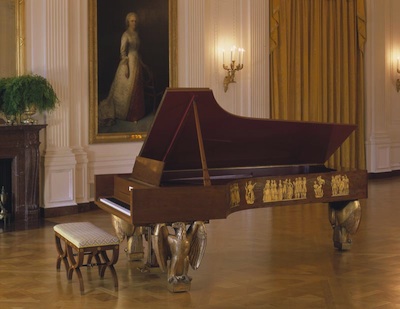 1938, Theodore Steinway presented to the American Nation with the 2nd Steinway Grand Piano, #300,000. To show gratitude to the American people, President Franklin Roosevelt accepted the instrument, "dedicating it to “the advance of music in every city, town, and hamlet in the country”.
1938, Theodore Steinway presented to the American Nation with the 2nd Steinway Grand Piano, #300,000. To show gratitude to the American people, President Franklin Roosevelt accepted the instrument, "dedicating it to “the advance of music in every city, town, and hamlet in the country”.
- 1941 – Steinway shipped 5,600 + pianos, 1,700 more than in the record-breaking year of 1926.
- 1943-June, Roman de Majewski, Steinway’s wholesale manager secured an order for 405, Olive Green (drab) Victory Model Uprights. Another order for 800 more soon followed. The ODGI model was a 40 inch upright that sat flat on the floor with no legs, looking like a box with a shelf sticking out. 2000 Victory Models were sold complete with their own tuning kits and heavy duty shipping box.
- 1950-July Yamaha visited Steinway & Sons and asked to carry the Steinway Pianos in their stores in Japan.
- In 1950, the retail price of a Steinway Model D was $6,900.
- 1955-Henry Z. Steinway became the 5th President of Steinway & Sons at the age of 40.
- 1956-Steinway along with the other American piano manufacturers all agreed to abandon ivory and start using plastic for keys.
- 1958-Van Cliburn, from Kilgore, Texas, wins the Tchaikovsky piano competition playing on a Steinway.
- 1964-Henry Steinway entertained some 800 friends at Steinway Hall to honor the tenth anniversary of Van Cliburn’s debut with the New York Philharmonic.
- 1967, January 31, a press party was held at the factory to celebrate the latest factory addition of 2 additional floors adding 60,000 square feet, this done to increase manufacturing of grands by 20%.
- In 1970, the retail price for a Steinway Model D was $8,275.
- 1972-Steinway & Sons is sold to CBS Musical Instruments (Owned Fender, Rogers Organs, Electro Music and a string maker) for 500,000 shares of CBS stock, or 7.1 shares of CBS stock for 1 share of Steinway & Sons Stock. Henry would remain President.
- 1982 – After a number of years with mixed results in using Teflon Bushings, Steinway & Sons switched production to a Teflon Impregnated felt for these bushings.
- 1985 – CBS announces sale of Steinway & Sons to John and Robert Birmingham.
- 1985-Bruce Stevens becomes 9th President of Steinway & Sons.
- 1986-Frank Mazurco introduced the Steinway & Sons Partnership Program as a support tool covering all aspects of a Steinway Merchandising Dealership.
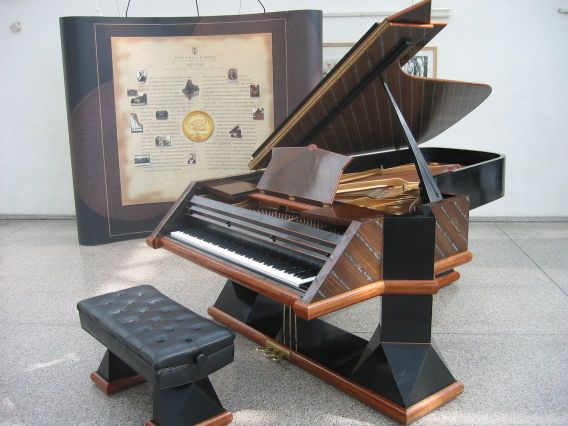 1987 Steinway Piano number #500,000, custom case by Wendell Castle presented in a gala concert at Carnegie Hall on the second of June 1988, celebrating Steinway’s 135th anniversary. The piano is decorated with signatures of the living Steinway Artists, executed in exotic wood veneers.
1987 Steinway Piano number #500,000, custom case by Wendell Castle presented in a gala concert at Carnegie Hall on the second of June 1988, celebrating Steinway’s 135th anniversary. The piano is decorated with signatures of the living Steinway Artists, executed in exotic wood veneers.
- 1988 June, The Steinway Foundation was formed at the time of the 135th anniversary of Steinway & Sons. A concert celebration was held at the Kennedy Center, three works for the celebration were debuted.
- 1989, The Glass Case, located in Steinway Hall on West 57th Street, holding the Paris Exhibition award, along with several others, was smashed and the medals stolen, never to be recovered.
- 1989, “Steinway” by Ronald V. Ratcliffe released depicting the history of Steinway & Sons including pictures of many of the historical and art case instruments produced by Steinway & Sons from their early beginnings.
- In 1990, the retail price for a Steinway Model D was $53,400.
- 1991-Steinway announces a mid-priced piano line called Boston.
- October 1, 1992 New Oil Portrait of Vladimir Horowitz by John Mfyer was unveiled in Steinway Hall to celebrate the 89th Anniversary of the Great Pianist’s birth.
- 1994 Opening of the Steinway Academy, the C. F. Theodore Steinway School for Concert Technicians, the first academy for concert technicians world-wide.
- 1995-Steinway & Sons sold for $100,000,000 to the Selmer Company owned by Investment Bankers, Kyle Kirkland and Dana Messina.
- 1995, “Steinway & Sons” by Dr. Richard Lieberman released. The first book based on the rich archive of Steinway business and family papers at LaGuardia Community College in New York, as well as on interviews with family members and company employees in the United States, Germany, and England, this authoritative and entertaining book tells the story of the most famous piano company in the world and of the family behind it.
- 1996 - Steinway Musical Instruments, Inc. goes public on August 2. 3.5 million shares are floated on the New York Stock Exchange at a share price of US$ 19. The Steinway share is quoted on Wall Street under the abbreviation “LVB“ (Ludwig van Beethoven).
- 1996 The unveiling of the portrait of Steinway Artist, Arthur Rubinstein, by New York Artist Jacob Collins. The unveiling of this portrait took place in the rotunda of Steinway Hall by Bruce Stevens and the Rubinstein family.
- 1996, Steinway & Sons was named “Company of the Year” by The Music Trades.
- 1997 Foundation of a new subsidiary of Steinway & Sons on 1st March called Steinway & Sons Japan, Ltd. in Tokyo.
- 1997, October, the book “88 Keys, The Making of a Steinway Piano,” released, written by Miles Chapin, a fifth generation descendant of Steinway’s founder, and son of Schuyler Chapin, Commissioner for the Department for Cultural Affairs for New York City.
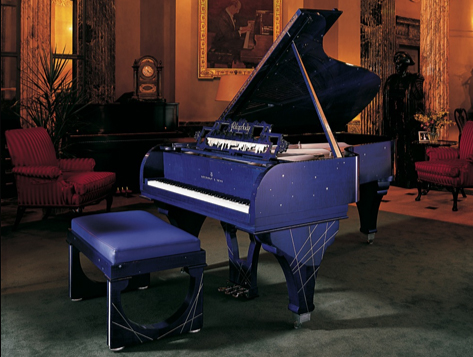 1998, Steinway’s Rhapsody, Limited edition series with only 24 to be produced, based on George Gershwin’s age when he wrote Rhapsody in Blue. Created to commemorate the birth of George Gershwin, appropriately named after the famous “Rhapsody in Blue," designed by internationally known Frank Pollaro. Features blue dyed maple veneer in high gloss clear lacquer with more than 400 hand cut mother of pearl stars. The traditional golden bronze plate has been replaced by gilded silver evoking the sophistication and style of the 1920’s. The music desk depicts a silhouette of the New York City’s skyline and the hardware is finished in a highly polished nickel-plate.
1998, Steinway’s Rhapsody, Limited edition series with only 24 to be produced, based on George Gershwin’s age when he wrote Rhapsody in Blue. Created to commemorate the birth of George Gershwin, appropriately named after the famous “Rhapsody in Blue," designed by internationally known Frank Pollaro. Features blue dyed maple veneer in high gloss clear lacquer with more than 400 hand cut mother of pearl stars. The traditional golden bronze plate has been replaced by gilded silver evoking the sophistication and style of the 1920’s. The music desk depicts a silhouette of the New York City’s skyline and the hardware is finished in a highly polished nickel-plate.
- 1998, Kluge, Europe’s largest manufacturer of piano keys, with which Steinway & Sons had been doing business for over a century, was acquired by Steinway Musical Instruments, Inc.
- 1999, Steinway Musical Instruments purchased O.S. Kelly, the largest manufacturer of piano plates in the United States.
- 1999 Steinway & Sons acquires Pianohaus Karl Lang of Munich, Germany’s largest piano dealer, opened Steinway Hall Munich.
- 2000 - The introduction of the Crown Jewel Collection, special exotic finishes from around the world known for their special color and grain were made available for Steinway pianos.
- 2000, John Lennon’s (of The Beatles) Steinway vertical piano sold for over $2 million dollars to pop star George Michael. This is the piano on which John composed the song “Imagine”.
- 2000 Steinway Tricentennial, Limited Edition, Model A 6’2”, a joint effort between Hamburg and New York, celebrating the 300th anniversary of the piano, designed by Dakota Jackson. The “S” curve is featured in the lid prop to carry the continuous flowing line from the back of the piano case to the floor. The music desk is designed to hold open the music like a pair of hands and is designed to roll toward and away from the player. Other features include a cantilever effect on the lid with tapered legs. The rim is raised in the back and the real leg has been pulled forward and inward, again creating the cantilever effect.
- 2000, January, Steinway & Sons announced the introduction of the William Steinway University, an in-house Management and Sales Training Educational Wing of Steinway & Sons Management to support and strengthen the sales and marketing of the Steinway Dealerships.
- 2000 October, Steinway & Sons announces the introduction of the 3rd Piano line called the Essex, designed by Steinway & Sons.
- On November 13, 2001, Steinway Hall was declared a New York City Landmark.
- 2002, May “Henry The Steinway” written by Peter Goodrich VP of C&A of Steinway & Sons and Sally Coveleskie, Director of Institutional Sales released. A children’s book about an aspiring piano student named Ana and her piano named Henry.
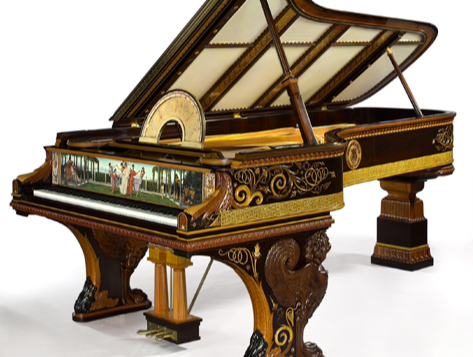 2002 Steinway Alma Tadema, Art Case, model D, recreated by Eric Schpo, In tribute to the magnificence of the original Alma-Tadema design built in 1883. The recreated Alma-Tadema sold for $675,000 to a museum in Tallahassee, Florida.
2002 Steinway Alma Tadema, Art Case, model D, recreated by Eric Schpo, In tribute to the magnificence of the original Alma-Tadema design built in 1883. The recreated Alma-Tadema sold for $675,000 to a museum in Tallahassee, Florida.
- 2002, The portrait of Arthur Rubinstein, which at the time was the latest addition to the Steinway Art Collection, was moved to Room #9, on the second floor in Steinway Hall on West 57th Street, and renamed “The Arthur Rubinstein Room," the first Salesroom in Steinway Hall to be named after a Steinway Artist.
- 2003, Historic 150th Anniversary Limited Edition, Art Case Paderewski Model Recreation, in honor of the 150th Anniversary, representing the rich colorful history of Steinway & Sons.
- The S.L.ED by Karl Lagerfeld was created in 2003, and was one of two instruments to celebrate the 150th Anniversary of Steinway & Sons.
- 2004 Official opening of the subsidiary Steinway Piano (Shanghai) Co., Ltd on January 1. The new corporation with limited liability is situated in Shanghai and supplies the Chinese dealer network.
- 2004, September, Roger Williams Limited Edition Golden Piano, debut on October 1, at the Jimmy Carter Presidential Library and Museum in Atlanta. The Celebration will also Roger Williams and former President Jimmy Carter celebrating both of their 80th Birthdays. The design is in the art-deco style prevalent when both men were born, the Roger Williams Limited Edition Gold Piano reflects architectural lines from that historic period, and features a gold-metallic finish accented by a high-gloss top coat.
- 2004, Model D #51,257, the very first Model D Concert Grand piano completed on January 31, 1884, was purchased by Steinway & Sons and completely rebuilt or refurbished, re-registered as CD-001 and will remain in the Concert & Artists Inventory.
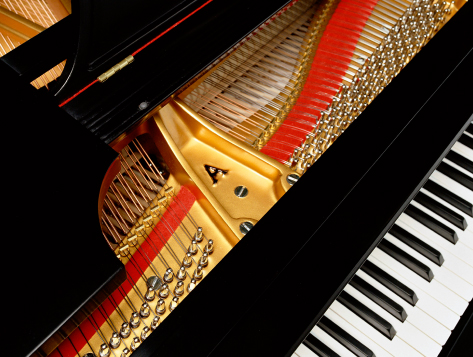 2005, Re-Introduction of the Model A (A2) 6’2.
2005, Re-Introduction of the Model A (A2) 6’2.
- April 17, 2005, the 125th Anniversary of Hamburg Factory in Germany. Introduced the Limited Edition, 125th Anniversary Grand Piano Designed by Goertz.
- 2006 After 52 years, Steinway-Haus Hamburg moves from the Colonnaden to Rondenbarg 15, and is now situated opposite to the Steinway factory in Hamburg.
- In 2006, Steinway & Sons unveils the Henry Z. Steinway Limited Edition piano to commemorate the 91st birthday of Henry Z. Steinway and the enduring contribution of four generations of the Steinway family to the world of music. 91 Model O’s and 91 Model B’s built.
- In 2006, the Steinway & Sons New York factory announced that the Model 'O' will return to production and will replace the Model L.
- 2007 Crane University of New York becomes All-Steinway School with the purchase of 141 Steinway pianos, the largest all Steinway purchase in the history of Steinway & Sons at that time.
- 2007 On 29th August, 2007 Steinway Musical Instruments Inc. announces the nomination of Thomas Kurrer as President of Steinway & Sons. Thomas Kurrer is the successor of Bruce Stevens, who retires after 22 years.
- In 2008, Steinway & Sons unveiled the latest model in the Legendary Collection of Steinway pianos, the re-creation of the #100,000 White House model. The piano was sold to Mr. Devoe Moore of Tallahassee Florida. Mr. More now has possession of the entire collection of these 3 pianos. The Alma-Tadama, the Peace Piano and the recreation of the #100,000 White House model presented to Theodore Steinway in 1903, the original piano is now at the Smithsonian Institute in Washington DC.
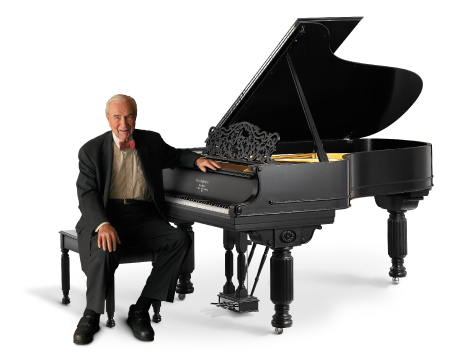 Until his death on September 18, 2008 at the age of 93, Henry Z. Steinway, the great-grandson of the Steinway founder, still worked for Steinway and put his signature on custom-made limited edition pianos. Henry Z. Steinway was the last family member to be the president of Steinway & Sons.
Until his death on September 18, 2008 at the age of 93, Henry Z. Steinway, the great-grandson of the Steinway founder, still worked for Steinway and put his signature on custom-made limited edition pianos. Henry Z. Steinway was the last family member to be the president of Steinway & Sons.
- November 18, 2008 – CCM, the College-Conservatory of Music at the University of Cincinnati (“UC”), purchased 165 New Steinway pianos, the largest unit purchase in Steinway’s 155-year history. (The price of the pianos is $4.1 million)
- On November 1, 2009 Southern Adventist University becomes the 100th All-Steinway School.
- Steinway & Sons launched the William E. Steinway Limited Edition piano on January 14, 2009, at the company’s annual convention in Newport Beach, California. This exquisite piano is a reproduction of the Steinway Centennial Piano, which was first introduced in 1876 at the nation’s Centennial Exposition in Philadelphia.
- In 2009, Steinway & Sons introduced the Boston Performance Edition Piano.
- Beginning in 2009, all Steinway D Concert Grands would be fitted with New York short legs and Hamburg large casters beginning with an Ebony Satin D #584808
- In 2010, the retail price of a Steinway Model D was $123,800
- On January 15, 2010 Steinway & Sons joins Twitter - @steinwayandsons
- October 12, 2010 – Steinway & Sons today announced the launch of its new Steinway & Sons record label. The first release on this label, Bach On A Steinway, debuted last week at #3 on the Billboard Traditional Classical Album Chart.
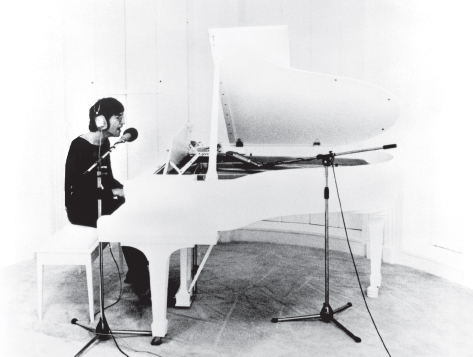 November 1, 2010 – To commemorate the 70th birthday of a true creative genius—legendary musician and songwriter John Lennon—Steinway & Sons has introduced the Imagine Series Limited Edition piano. The Imagine Series Limited Edition is modeled after the white Steinway grand piano that John Lennon presented to Yoko Ono on her birthday in 1971, which is still at their famous Manhattan residence – the Dakota.
November 1, 2010 – To commemorate the 70th birthday of a true creative genius—legendary musician and songwriter John Lennon—Steinway & Sons has introduced the Imagine Series Limited Edition piano. The Imagine Series Limited Edition is modeled after the white Steinway grand piano that John Lennon presented to Yoko Ono on her birthday in 1971, which is still at their famous Manhattan residence – the Dakota.
- December 14, 2010 – Steinway & Sons announced the addition of the Central Conservatory of Music, School of Piano, located in Beijing, China, to its illustrious list of All-Steinway Schools. The world-renowned conservatory owns 127 Steinway grand pianos and 41 Boston grand pianos designed by Steinway & Sons.
- On November 4th, 2010, Steinway & Sons unveiled something it had never built before – a full-featured digital Metronome App for iPhone, iPod touch, and iPad.
- September 15, 2011 – Steinway & Sons debuted version 2.0 of its breakthrough Etude app for learning, reading, and buying sheet music on the Apple® iPad®. This latest version of Etude adds a growing commercial sheet music store, new ways to display and read music, and a refined interface.
- On November 11, 2010, to kick off this exclusive partnership, BMW presented the special limited-edition BMW Individual 7 Series Composition inspired by Steinway & Sons at the Steinway factory in Hamburg, Germany.
- On December 12, 2011, Billy Joel becomes the only non-classical performer to be honored with a portrait at the prestigious Steinway Hall in New York.
BONUS FACTS
- At the 58th Street side of the basement is the renowned Steinway “piano bank” where piano professionals come to select instruments they will use in concerts, in recordings, and on tour. As one accomplished concert pianist put it, “There isn’t a first class piano player in the world who does not expect to visit the Steinway Hall concert basement before a New York performance. It is a piano mecca – sort of the center of the piano universe.”
- There are 12,116 individual parts that make up a Steinway grand piano.
- The action for just 1 key is made up of over 57 individual parts (so for 88 keys that’s ~4,500 parts).
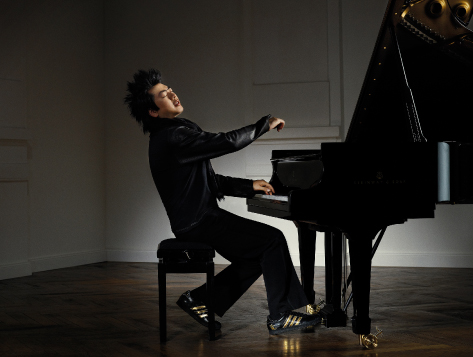 There are over 1,600 Steinway Artists worldwide - about 800 in the U.S.
There are over 1,600 Steinway Artists worldwide - about 800 in the U.S.
- Steinway Artists are not paid to play a Steinway nor do they receive a Free Steinway for personal use. Steinway Artists choose to perform on Steinway pianos.
- “A 10 year old Steinway in good condition, usually sells for about 75 percent of the current retail price, which goes up about 4 percent each year.” Reuters, November 2003
- The Steinway & Sons’ patented "Diaphragmatic Soundboard"—now found in every Steinway piano produced today—was first developed on the Model S.
- The wood used to build Steinway pianos is dried and seasoned for approximately 2 years before ever being used to build a piano.
- The Steinway Concert Grand Model D has the power and projection to be heard in a 2000-seat concert hall—without the aid of a microphone.
- The soundboard of a Steinway Model K-52 upright has the same “speaking area” as that of a six-foot grand piano.
- The first major artist brought to U.S. by Steinway & Sons was Anton Rubinstein, who toured the U.S. from 1872 to 1873.
- To date, Steinway & Sons has been granted over 125 patents.
- There are currently 135 All-Steinway Schools worldwide (as of March 5, 2012).
- Since 1853 Steinway & Sons has pursued a single ideal: Make the finest pianos in the world as stated by Henry E. Steinway “Build the best piano possible, sell it for the lowest price consistent with quality.”
- All Steinway grand piano rims are continuously bent in presses designed and built by Steinway. Together, the inner and outer rims form one united rim. After being glued the rims are removed from the presses, chalk-dated and stored upright in a conditioning room. Rims remain in the conditioning room between 10 and 16 weeks depending on thickness and size. The room temperature is set at 85 degrees Fahrenheit; the relative humidity is 45%.
- The method of rim bending was invented by C.F. Theodore Steinway. It became U.S. Patent no. 229298 on June 22, 1880.
- The Oberlin Conservatory of Music in Ohio holds the longest partnership with Steinway. They have used Steinway pianos exclusively since 1877, just 24 years after Steinway was founded.
- The Steinway Model D Concert Grand piano (8’11) weighs 990 lbs.
- The Steinway Model S Baby grand piano (5’1) weighs 540 pounds.
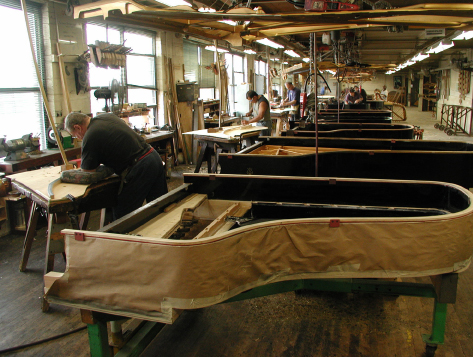 Over 300 Craftspeople work in the New York Factory.
Over 300 Craftspeople work in the New York Factory.
- The NY Steinway factory is located on 11 acres of land
- A piano restored by the Steinway Restoration Center receives the same 5-Year warranty as a new Steinway piano.
- The New York Factory averages 4.3 grand pianos built per production day.
- Around 1,000 grand pianos and 250 upright pianos are produced per year in the New York Factory. The Hamburg Steinway Factory produces a similar number of instruments.
- Over 90% of the pianos produced in the New York Factory are Ebony.
- At last count (2010-11 concert season), 97% of concert soloists chose to play on a Steinway piano vs. all other brands combined.
- The Steinway Concert “Piano Bank” has over 300 pianos in use Worldwide.
- The Steinway Model K-52 upright weighs 600 pounds. That's more than the 5’1 Model S baby grand (540 pounds) and the Model M Medium Grand (560 pounds).
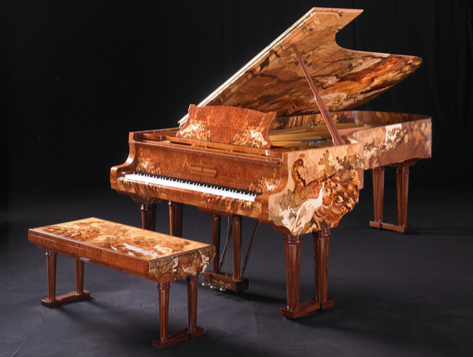 The world's most expensive Steinway grand piano is a Steinway art case piano built by Steinway's factory in Hamburg, Germany, in 2008 for €1.2 million. It took Steinway about four years to build the piano. The piano is named Sound of Harmony and is decorated with inlays of 40 different woods, including the lid which replicates artwork by Chinese painter Shi Qi. It was conceived and commissioned by Chinese art collector and music lover, Guo Qingxiang.
The world's most expensive Steinway grand piano is a Steinway art case piano built by Steinway's factory in Hamburg, Germany, in 2008 for €1.2 million. It took Steinway about four years to build the piano. The piano is named Sound of Harmony and is decorated with inlays of 40 different woods, including the lid which replicates artwork by Chinese painter Shi Qi. It was conceived and commissioned by Chinese art collector and music lover, Guo Qingxiang.
- The cast iron plate is often called the “backbone” of the piano; and indeed, it must be in order to withstand over 20 tons of string tension.
- Steinway does not sell their soundboards to anyone. Not even, their dealers can purchase a soundboard.
- The Juilliard School possesses 260 Steinway pianos in practice rooms, teaching studios and performance halls.
- Based on a 4% increase per year, the retail price of a Steinway Model D will be $183,200 in 2020.
- On March 5, 2013 Steinway & Sons will celebrate its 160th Anniversary.
A Special Thank you to Anthony Gilroy and Jim Hoover at Steinway & Sons for sharing their help on this celebration project.